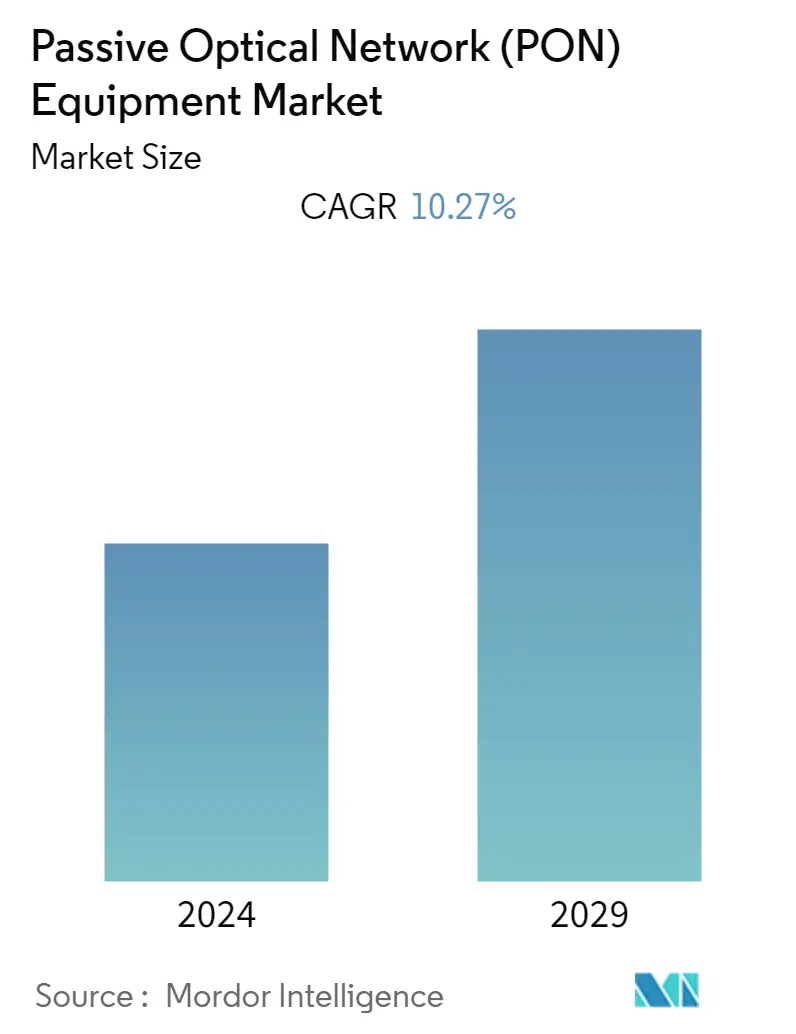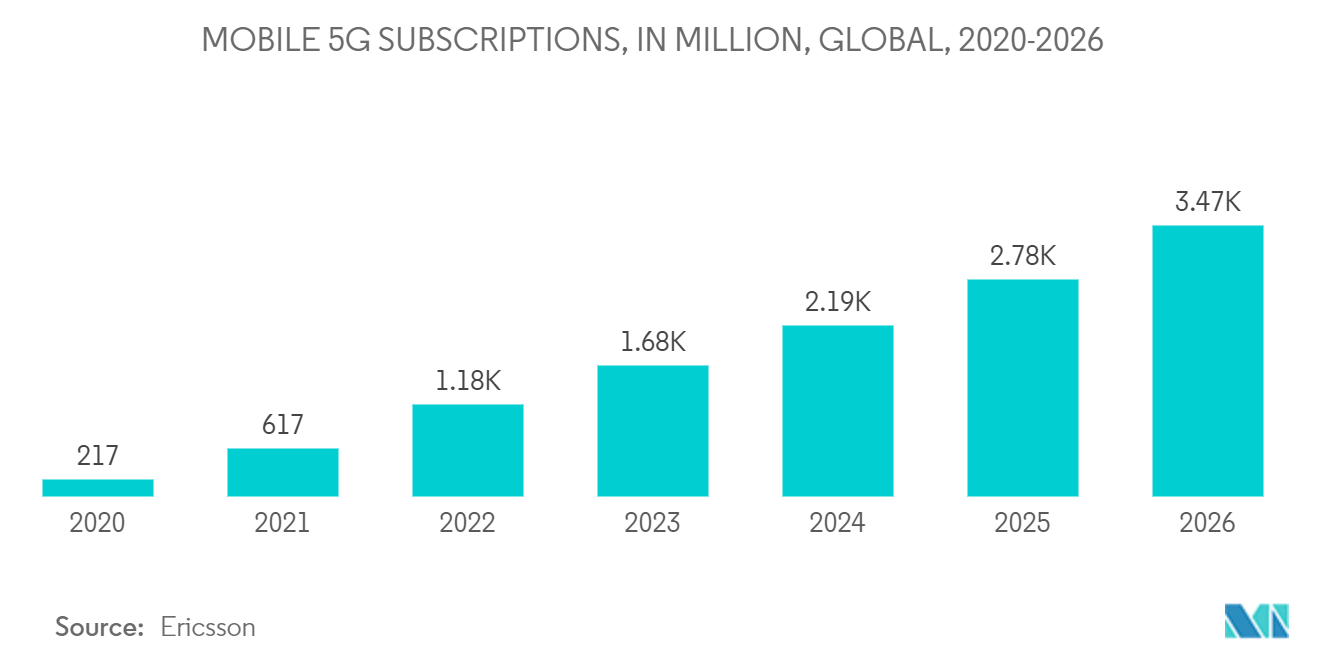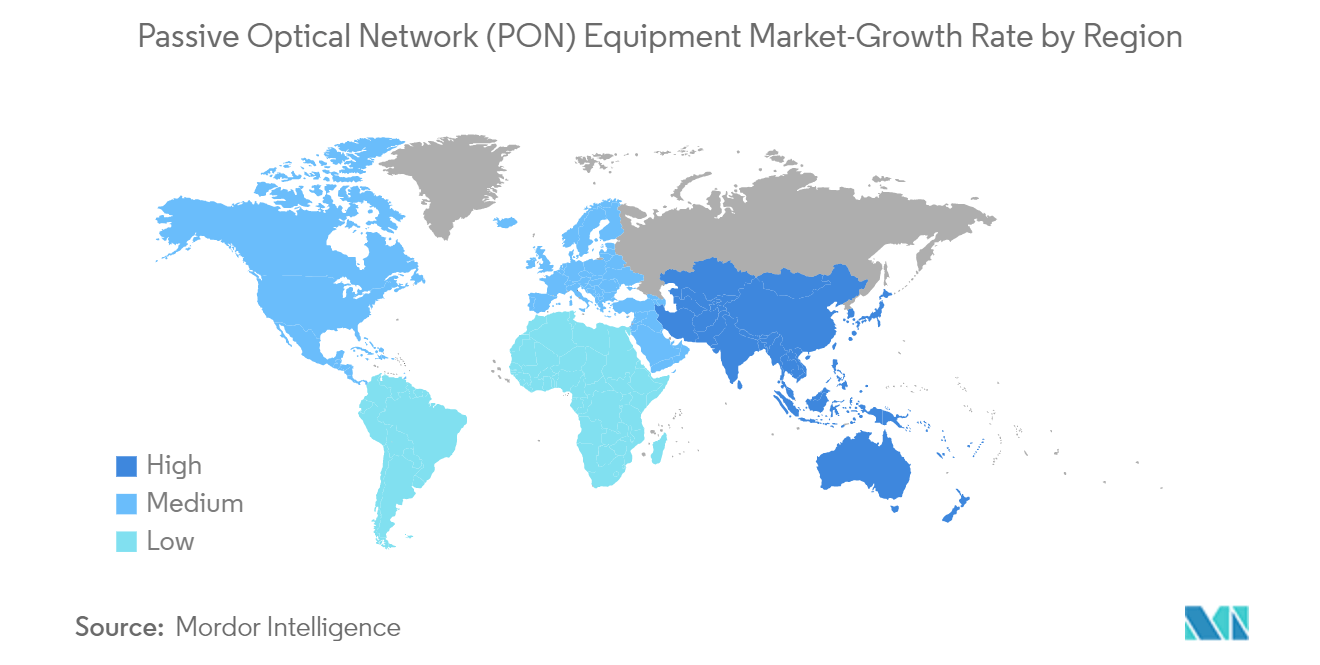Passive Optical Network (PON) Market Size

| Study Period | 2019 - 2029 |
| Base Year For Estimation | 2023 |
| CAGR | 10.27 % |
| Fastest Growing Market | Asia Pacific |
| Largest Market | North America |
| Market Concentration | Medium |
Major Players-equipment-market/passive-optical-network-(pon)-equipment-market_1591159407616_MP_Passive_Optic_Network_(PON)_Equipment_Market.webp)
*Disclaimer: Major Players sorted in no particular order |
Passive Optical Network (PON) Market Analysis
The Passive Optical Network (PON) Equipment Market is expected to grow at a CAGR of 10.27% over the forecast period. In recent years, the penetration of LTE networks and fixed broadband subscription rapidly grew and is expected to follow the trend in the forecast period. Also, the Ericsson mobility report mentioned the fixed broadband connection is expected to grow steadily by 3% year-on-year till 2024, which is expected to drive the PON equipment market growth.
- Additionally, governments are taking initiatives like smart city programs with fiber optic-rich networks to enable the smooth flow of IoT infrastructure. Fiber optic network allows the technology to drive utilities like water, electricity, wastewater, sewerage management, security, and communication. According to the UN, over 68% of the global population is estimated to live in urban areas by 2050, which will fuel more smart city projects globally.
- The demand for networks with greater capacity is increasing as data traffic keeps growing exponentially. Because they can deliver high bandwidths across great distances, passive optical networks (PONs) present a viable solution to this issue. The rising need for bandwidth is the primary factor driving the passive optical network market growth. Consumers demand faster and more dependable networks as video streaming and other bandwidth-intensive apps proliferate. Due to their ability to deliver gigabit speeds over considerable distances without the use of active components or pricey optical fiber, PONs are uniquely suited to meet this demand.
- Due to the COVID-19 outbreak, countries worldwide implemented preventive measures. While schools were closed and communities were asked to stay at home, many organizations were finding ways to enable employees to work from their homes. Telecom companies actively made efforts to build full-fiber infrastructure to deliver an ultrafast, ultra-reliable, and futureproof broadband network.
- For instance, the average monthly mobile user in China's online traffic increased from 7.8 GB to 14.9 GB over the past three years, driven by 5G, according to data released at the global 5g convention. It facilitated remote work, online education, digital life, scientific research, and epidemic prevention and control during the COVID-19 pandemic. These factors significantly contribute to the market growth rate during the forecast period.
Passive Optical Network (PON) Market Trends
This section covers the major market trends shaping the Passive Optical Network (PON) Equipment Market according to our research experts:
GPON Equipments is Expected to Grow Significantly
- Enhanced mobile broadband (eMBB) provides greater data bandwidth due to latency improvements on 5G NR and 4G LTE. It led most operators towards new use cases for 5G by delivering mobile broadband services directly to customers. It, thus, complements ample capacity for digital services, owing to better spectral efficiency, power, and increasing smartphone data usage in developed & developing countries.
- Recently, VIAVI Solutions Inc., a test, measurement, assurance solutions, and advanced precision optical solutions provider, announced Fusion JMEP 10, a small form-factor pluggable (SFP+) Gigabit Ethernet transceiver for network test, turn-up, and performance monitoring up to 10 GbE. The Fusion JMEP 10, which is part of the VIAVI NITRO lifecycle management platform, addresses10 GbE emergence as the dominant Ethernet bandwidth for applications such as 5G xHaul, Business Ethernet Services, Distributed Access Architecture (DAA) for Cable and Gigabit Passive Optical Networks (GPON/XGSPON) for Fiber Access Networks.
- The compatibility of 5G and fiber results in a reciprocal partnership. In areas where connecting fiber to the home is challenging, expensive, or takes too long, 5G fixed wireless access can fill in the gaps in FTTH deployments and expand coverage. Customers leave the cellular network for Wi-Fi, offloading 5G traffic to Wi-Fi and FTTH. It facilitates managing RAN capacity and prices effectively, freeing up 5G capacity for mission-critical applications and improving the customer experience at home. Users of mobile devices anticipate substantially faster speeds and global coverage from 5G, which requires a high-performance mobile transport network. Further, to offer that transport, a passive optical network (PON) technology-based FTTH networks already in existence are used.
- With the accelerating rollout of GPON worldwide, telecom operators are also actively moving toward the next step in fiber rollouts. The Gigabyte era will rapidly enter optical access networks during the next five years. The 10G PON passive optical network technology is distinguished by its broad coverage and high bandwidth. When installing high-speed optical access networks, operators around the world favor this technology since it can give Gigabyte access to 30-40 households on a single system.

Asia-Pacific Region to Witness the Fastest Growth
- Recently, there is an increased emphasis on high-speed internet and 5G network. The major driving countries in the region for the same are emerging countries, including China, Japan, Taiwan, India, and Australia. China includes an established ecosystem for 5G and is expected to grow further in the forecast period. However, the 5G technology is expected to serve as a hotspot technology with the current mobile broadband; the growth is expected to be gradual.
- China is advancing towards a new Gigabit ultra-wide stage, represented by 10G PON technology, and leading the global in terms of optical networks' fundamental advantages. Primary telecom providers effectively put up concise development plans for a gigabit optical network. Over 300 cities nationwide had a gigabit broadband access network in 2021, serving more than 80 million households. More than 2.7 million National Gigabit internet access consumers have received gigabit commercial packages from most provincial telecommunications providers. The number of new users surpassed the total number from the previous year in just five months.
- In addition to building hundreds of double Gigabyte boutique communities throughout the city, Beijing Mobile will hasten the construction of F5G. The first FTTR White Paper, published by Guangzhou Telecom and Huawei, ensures Gigabit broadband full house coverage through an all-optical residential network technology. To strengthen the firm foundation of the digital economy, Hangzhou Mobile published the "Double 5G" Digital City White Paper. China's Gigabit Broadband will continue to broaden its coverage to connect many devices and terminals, achieve multi-scenario applications such as home, enterprise, business, and industrial manufacturing, and give consumers reliable, high-speed bandwidth access capacity.
- Chinese telecom companies have invested more than USD 59.4 billion in 5G, generating more than USD 59.4 billion in 5G, generating an estimated USD 1.25 trillion in economic output. It shows the significant contribution new network infrastructure makes to economic growth. The commercial use of 5G entered a positive feedback loop, according to Xiang Libin, vice-minister of science and technology, and noted that after more than three years of development, industry-oriented 5G applications have increased from zero to one. These factors are analyzed to contribute to the market growth rate during the forecast period.

Passive Optical Network (PON) Industry Overview
The market for passive optical network equipment is moderately consolidated due to the presence of a few companies in the market. Also, these companies are investing extensively in offering customers a wide range of technologies. Moreover, these companies continuously invest in strategic partnerships, acquisitions, and product development to gain market share. Some of the current advancements by the companies are listed below.
- May 2022 - At the FTTH Conference 2022 in Vienna, Austria, ZTE Corporation (0763. HK / 000063.SZ), a significant global supplier of telecoms, enterprise, and consumer technology solutions for the mobile internet, declared that it had unveiled the prototype of the first Optical Network Unit (ONU) in the industry to offer both 50-Gigabit-Capable Passive Optical Networking (50G PON) and Wi-Fi 7 technologies.
Passive Optical Network (PON) Market Leaders
-
ADTRAN, Inc.
-
Calix, Inc.
-
Huawei Technologies Co., Ltd.
-
Mitsubishi Electric Corporation
-
Motorola Solutions, Inc.
*Disclaimer: Major Players sorted in no particular order
-equipment-market/passive-optical-network-(pon)-equipment-market_1591102407722_MC_Passive_Optic_Network_(PON)_Equipment_Market.webp)
Passive Optical Network (PON) Market News
- November 2022: Ciena, the optical networking company, expanded its technology offering into the broadband access, virtualized routing, and subscriber management domains with the acquisition of network-edge telco software specialist Benu Networks and the scheduled acquisition of next-generation passive optical network (PON) vendor Tibit Communications.
- In July 2022-Nokia has announced that it installed a passive optical LAN (POL) solution for Orange at 20 sites in France, including the new Orange Headquarters, Bridge, in Issy-les-Moulineaux, close to Paris. The POL solution connects more than 5,000 endpoints, including Wi-Fi and hard-wired terminals, and replaces the current copper-based LAN.
Passive Optical Network (PON) Market Report - Table of Contents
1. INTRODUCTION
- 1.1 Study Assumptions and Market Definition
- 1.2 Scope of the Study
2. RESEARCH METHODOLOGY
3. EXECUTIVE SUMMARY
4. MARKET DYNAMICS
- 4.1 Market Overview
-
4.2 Porter's Five Forces Analysis
- 4.2.1 Bargaining Power of Suppliers
- 4.2.2 Bargaining Power of Buyers/Consumers
- 4.2.3 Threat of New Entrants
- 4.2.4 Threat of Substitute Products
- 4.2.5 Intensity of Competitive Rivalry
- 4.3 Assessment on the Impact of COVID-19 on the market
5. MARKET DYNAMICS
-
5.1 Market Drivers
- 5.1.1 Demand for secure and reliable network operation
- 5.1.2 Eco-friendly substitute as compared to traditional networks
- 5.1.3 Low total cost of ownership and high return on investment
-
5.2 Market Restraints
- 5.2.1 High component cost at operator interface
6. MARKET SEGMENTATION
-
6.1 By Structure
- 6.1.1 Ethernet Passive Optical Network (EPON) Equipment
- 6.1.2 Gigabit Passive Optical Network (GPON) Equipment
-
6.2 By component
- 6.2.1 Wavelength Division Multiplexer/De-Multiplexer
- 6.2.2 Optical filters
- 6.2.3 Optical power splitters
- 6.2.4 Optical cables
- 6.2.5 Optical Line Terminal (OLT)
- 6.2.6 Optical Network Terminal (ONT)
-
6.3 By Geography
- 6.3.1 North America
- 6.3.2 Europe
- 6.3.3 Asia-Pacific
- 6.3.4 Latin America
- 6.3.5 Middle East & Africa
7. COMPETITIVE LANDSCAPE
-
7.1 Company Profiles
- 7.1.1 ADTRAN, Inc.
- 7.1.2 Calix, Inc.
- 7.1.3 Huawei Technologies Co., Ltd.
- 7.1.4 Mitsubishi Electric Corporation
- 7.1.5 Motorola Solutions, Inc.
- 7.1.6 Nokia Corporation
- 7.1.7 Telefonaktiebolaget LM Ericsson
- 7.1.8 Tellabs, Inc.
- 7.1.9 Verizon Communications, Inc.
- 7.1.10 ZTE Corporation
- *List Not Exhaustive
8. INVESTMENT ANALYSIS
9. MARKET OPPORTUNITIES AND FUTURE TRENDS
** Subject To AvailablityPassive Optical Network (PON) Industry Segmentation
A passive optical network (PON) is a fiber-optic network that utilizes optical splitters and a point-to-multipoint topology to transmit data to numerous user endpoints. The term "passive" describes the unpowered state of the fiber and the splitting/combining elements. The scope of the study for the passive optical network (PON) equipment market considered various structural equipment offered by vendors worldwide. As most end-user industries use services from ISPs for their communication network, the end-user application segmentation is limited to telecommunication and data centers.
The Passive Optical Network (PON) Equipment Market is segmented by structure (EPON, GPON), component (wavelength division Multiplexer/De-Multiplexer, optical filters, optical power splitters, optical cables, Optical Line Terminal (OLT), and Optical Network Terminal (ONT)), and geography (North America, Europe, Asia-Pacific, Latin America, and Middle East & Africa).
The market sizes and forecasts are provided in value (USD million) for all the above segments.
| By Structure | Ethernet Passive Optical Network (EPON) Equipment |
| Gigabit Passive Optical Network (GPON) Equipment | |
| By component | Wavelength Division Multiplexer/De-Multiplexer |
| Optical filters | |
| Optical power splitters | |
| Optical cables | |
| Optical Line Terminal (OLT) | |
| Optical Network Terminal (ONT) | |
| By Geography | North America |
| Europe | |
| Asia-Pacific | |
| Latin America | |
| Middle East & Africa |
Passive Optical Network (PON) Market Research FAQs
What is the current Passive Optical Network (PON) Equipment Market size?
The Passive Optical Network (PON) Equipment Market is projected to register a CAGR of 10.27% during the forecast period (2024-2029)
Who are the key players in Passive Optical Network (PON) Equipment Market?
ADTRAN, Inc., Calix, Inc., Huawei Technologies Co., Ltd., Mitsubishi Electric Corporation and Motorola Solutions, Inc. are the major companies operating in the Passive Optical Network (PON) Equipment Market.
Which is the fastest growing region in Passive Optical Network (PON) Equipment Market?
Asia Pacific is estimated to grow at the highest CAGR over the forecast period (2024-2029).
Which region has the biggest share in Passive Optical Network (PON) Equipment Market?
In 2024, the North America accounts for the largest market share in Passive Optical Network (PON) Equipment Market.
What years does this Passive Optical Network (PON) Equipment Market cover?
The report covers the Passive Optical Network (PON) Equipment Market historical market size for years: 2019, 2020, 2021, 2022 and 2023. The report also forecasts the Passive Optical Network (PON) Equipment Market size for years: 2024, 2025, 2026, 2027, 2028 and 2029.
Passive Optical Network Industry Report
Statistics for the 2023 Passive Optical Network market share, size and revenue growth rate, created by Mordor Intelligence™ Industry Reports. Passive Optical Network analysis includes a market forecast outlook to 2029 and historical overview. Get a sample of this industry analysis as a free report PDF download.



